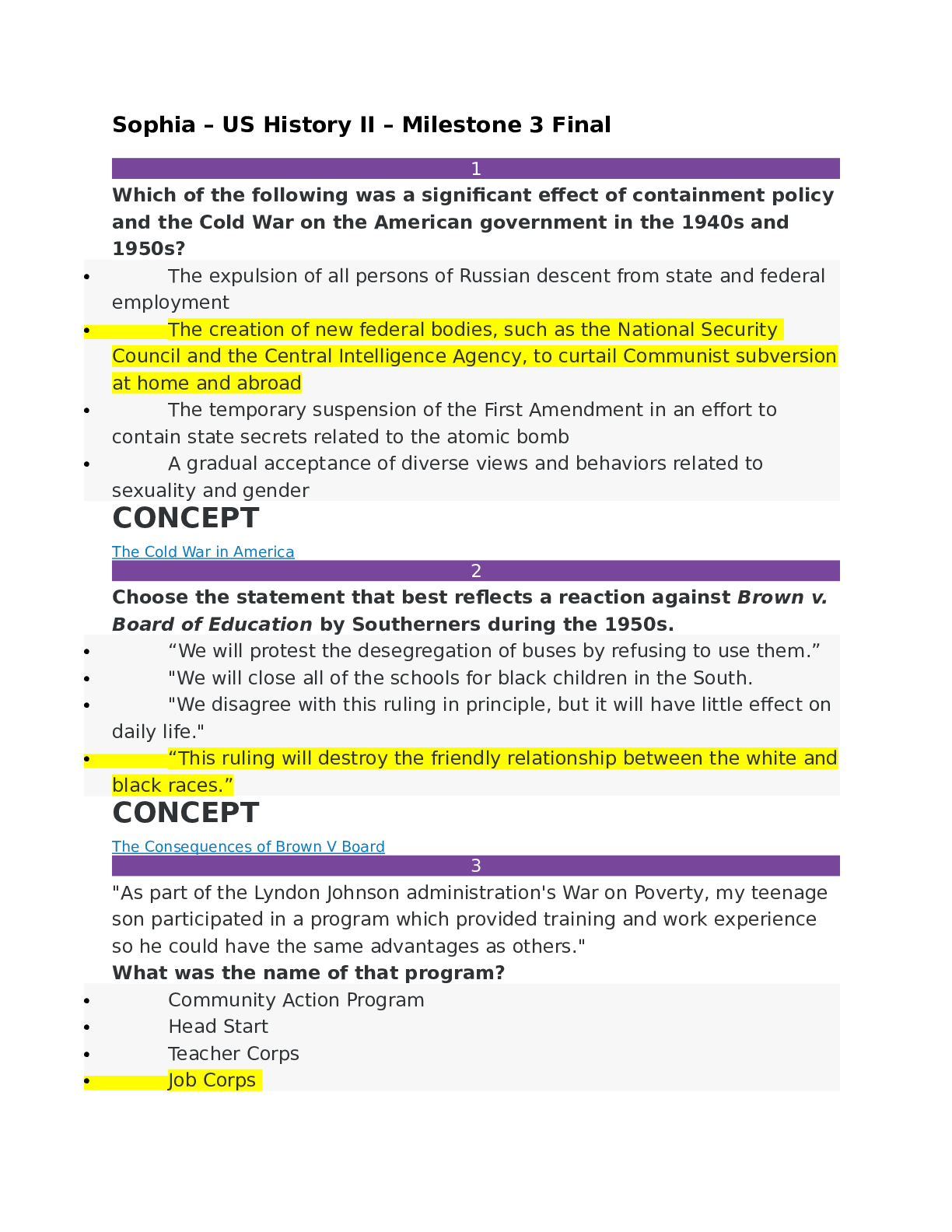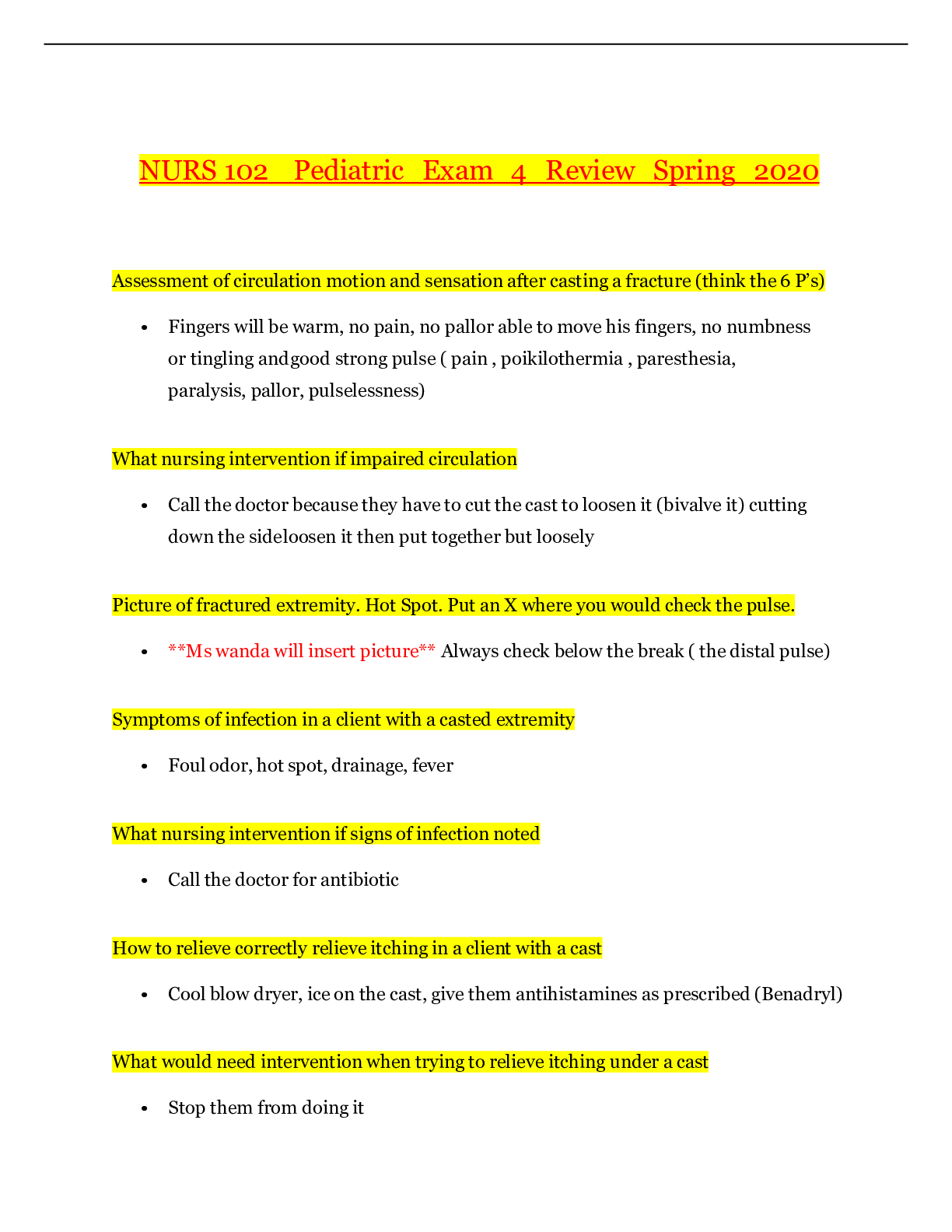NSG 2400 EXAM 4 REVIEW (Questions & Answers)
Document Content and Description Below
A client who has a diagnosis of endometriosis is concerned about the side effect of hot flashes from her prescribed medications. Which medication should the nurse explain causes this side effect? 1. ... Estrogen 2. Leuprolide 3. Diclofenac 4. Ergonovine A client at the women's health clinic tells the nurse that she has endometriosis. What factors associated with endometriosis does the nurse anticipate the client will report? Select all that apply. 1. Insomnia 2. Ecchymosis 3. Rectal pressure 4. Abdominal pain 5. Skipped periods 6. Pelvic infections The nurse is obtaining a health history from a client with endometriosis. What consequences can occur as a result of this disorder? Select all that apply. 1. Menopause 2. Metrorrhagia 3. Impaired fertility 4. Bowel strictures 5. Voiding difficulties The parents of a 12-year-old boy with cystic fibrosis (CF) ask the nurse why he needs a glucose tolerance test. What information should the nurse consider before replying? 1. Pancreatic scarring predisposes the child to diabetes. 2. The thickened mucus blocks the insulin-secreting glands. 3. The test reveals the degree to which the child adheres to the diet. 4. Adjustments of the dosage of pancreatic enzymes are based on the results of the test. A nurse is caring for several school-aged children with cystic fibrosis. Why does the nurse anticipate that these children will probably be small and underdeveloped for their age? 1. There is muscle atrophy from lack of motor activity. 2. There is decreased secretion of pituitary growth hormone. 3. These children digest little food because pancreatic enzymes are blocked. 4. These children have anorexia with minimal amounts of nutritional intake A nurse is caring for a child with a diagnosis of cystic fibrosis. Which schedule of chest physiotherapy (CPT) is best? 1. Three times a day, before meals 2. Three times a day, halfway between meals 3. Two times a day, on awakening and at bedtime 4. Two times a day, after breakfast and after dinner A nurse manager is providing a class on cystic fibrosis for the pediatric staff nurses. Physiologic adaptations to cystic fibrosis are a result of which problem? 1. Dysfunction of sweat glands 2. Inactivity of respiratory tract cilia 3. Pathology of mucus-secreting glands 4. Overproduction of endocrine gland activity A nurse is explaining the genetic pattern of inheritance to the parents of a 6-year-old child with newly diagnosed cystic fibrosis. The parents should be taught that the disorder follows an autosomal recessive pattern of inheritance and occurs when the parents have what relationship to the disease? 1. One parent has cystic fibrosis 2. Both parents have cystic fibrosis 3. One parent is a carrier of cystic fibrosis 4. Both parents are carriers of cystic fibrosis A nurse is reviewing previous education with the parents and a 12-year-old child with cystic fibrosis (CF). The disease was diagnosed when the child was 3 years old and has resulted in one hospitalization for a respiratory infection. For which potential complications of CF should the family be alert? Select all that apply. 1. Diabetes 2. Hematuria 3. Nasal polyps 4. Prolapsed rectum 5. Pulmonary infections 6. Urinary tract infections A school-aged child with cystic fibrosis has been admitted with a respiratory infection. The child has been very disruptive and angry with staff and parents. What does the nurse suspect is the reason for the child's uncooperative behavior? 1. Spoiled and needs to be adequately disciplined 2. Resentful of the restriction of the hospitalizations 3. Having a reaction to the new respiratory medications 4. Angry about dietary restrictions related to the disease A school-aged child who has cystic fibrosis complains to the nurse about having to undergo chest physiotherapy and wonders why it is necessary. How does the nurse explain the primary purpose of chest physiotherapy in terms the child can understand? 1. It mobilizes secretions. 2. It prevents a barrel chest. 3. It dilates the bronchioles. 4. It provides humidification. The parents of a toddler with newly diagnosed cystic fibrosis (CF) tell a nurse that even though they were told it is an inherited disorder, there is no history of CF in the family. How can the nurse clarify the way in which the disease was inherited? 1. It is a mutated gene. 2. It involves an X-linked gene. 3. The inheritance is autosomal recessive. 4. The inheritance is autosomal dominant. A nurse is teaching the parents of a 3-year-old child with a diagnosis of cystic fibrosis about their child's special needs. What statement indicates that the parents need further teaching about the issues related to cystic fibrosis? 1. "We'll have to air-condition the whole house." 2. "We'll have to move to a very warm climate." 3. "Our child will be taking pancreatic enzymes with meals." 4. "Our child will need skin care after each bowel movement." The parents of an infant with newly diagnosed cystic fibrosis ask a nurse what causes the foul-smelling, frothy stool. What is the best response by the nurse? 1. Undigested fat 2. Sodium and chloride 3. Partially digested carbohydrates 4. Lipase, trypsin, and amylase release A nurse who is caring for a 2-day-old neonate suspects that the infant has cystic fibrosis. What early sign of this disorder did the nurse identify? 1. Meconium ileus 2. Imperforate anus 3. Hemoglobin level of 20 g/dL (200 mmol/L) 4. Total bilirubin level of 8 mg/dL (136 mmol/L) A male adolescent with cystic fibrosis, whose parents are both carriers of the disease, asks the nurse, "When I have children, could they have cystic fibrosis like me?" What information should the nurse consider before responding? 1. Men with cystic fibrosis usually are sterile, although sexual function is not affected. 2. Men with cystic fibrosis generally have a 50% chance of having children with the disease. 3. Women will pass this disease to their children because it is carried on the sex chromosome. 4. Women have a 25% chance of passing the disease to their children if their parents are carriers A nurse is caring for a 10-year-old child with cystic fibrosis who is taking a pancreatic enzyme replacement. Which effect of the medication will the nurse look for that may indicate the enzyme is inadequate? 1. Generalized edema 2. Acute nephrolithiasis 3. Abdominal cramping 4. Sudden gain in weight What will a nurse teach the parents of a toddler with newly diagnosed cystic fibrosis about the administration of vitamins A, D, E, and K? 1. Offer them in a water-miscible form. 2. Give them during meals and snack times. 3. The dosage is based on the child's height and weight. 4. Present them to the child with fruit juice rather than milk. A nurse is caring for a client with a history of chronic obstructive pulmonary disease (COPD) who develops a pneumothorax and has a chest tube inserted. Which primary purpose of the chest tube will the nurse consider when planning care? 1. Lessens the client's chest discomfort 2. Restores negative pressure in the pleural space 3. Drains accumulated fluid from the pleural cavity 4. Prevents subcutaneous emphysema in the chest wall A client with a pneumothorax has a chest tube inserted and attached to a closed chest drainage system. The client asks, "Why is the tube in my chest hooked up to a contraption with water in it?" How does the nurse explain the function of the water? 1. Promotes pleural drainage via gravity 2. Measures the pressures in the chest wall 3. Prevents reflux of air back into the chest 4. Ensures bubbling in the water-seal chamber A nurse is caring for a client with a pneumothorax who has a chest tube in place. What should the nurse do when caring for this client? 1. Encourage range of motion to the client's arm on the affected side 2. Administer the prescribed cough suppressant at the prescribed times 3. Empty and measure the drainage in the collection chamber each shift 4. Apply clamps below the insertion site when getting the client out of bed The nurse is caring for a client with a pneumothorax and chest tube. To evaluate the effectiveness of a chest tube, the nurse assesses for which finding? 1. Productive coughing 2. Return of breath sounds 3. Increased pleural drainage in the chamber 4. Constant bubbling in the water-seal chamber A client has a chest tube for a pneumothorax. The nurse finds the client in respiratory difficulty, with the chest tube separated from the drainage system. What should the nurse do? 1. Obtain a new sterile drainage system. 2. Use two clamps to close the drainage tube. 3. Place the client in the high-Fowler position. 4. Reconnect the client's tube to the drainage system. A client has a pneumothorax, and a closed-chest drainage system is inserted to allow the lung to reinflate. Identify the chamber in the figure below that provides the water seal. What clinical indicators should the nurse expect to identify when assessing an individual with a spontaneous pneumothorax? Select all that apply. 1. Hematemesis 2. Shortness of breath 3. Unilateral chest pain 4. Increased thoracic motion 5. Mediastinal shift toward the involved side A client with emphysema experiences a sudden episode of shortness of breath and is diagnosed with a spontaneous pneumothorax. The client asks, "How could this have happened?" The nurse's response is based on what likely cause of the spontaneous pneumothorax? 1. Pleural friction rub 2. Tracheoesophageal fistula 3. Rupture of a subpleural bleb 4. Puncture wound of the chest wall When providing discharge teaching for a young female client who had a pneumothorax, it is important that the nurse include the signs and symptoms of a recurring pneumothorax. What is the most important symptom that the nurse should teach the client to report to the healthcare provider? 1. Substernal chest pain 2. Episodes of palpitation 3. Severe shortness of breath 4. Dizziness when standing up After a spontaneous pneumothorax, the client becomes extremely drowsy, and the pulse and respirations increase. What do these client responses indicate to the nurse? 1. Hypercapnia 2. Hypokalemia 3. Increased PO2 4. Respiratory alkalosis A nurse is caring for a client with a pneumothorax who has a chest tube in place with a closed drainage system. Which of these actions by the nurse is correct? 1. Strip the chest tube periodically. 2. Administer the prescribed cough suppressant at the scheduled times. 3. Empty and measure the drainage in the collection chamber each shift. 4. Keep the drainage system lower than the level of the client's chest. A client tells the nurse that the client's chest tube is scheduled to be removed soon. Before it is removed, what is the nurse aware of? 1. The drainage system will be disconnected from the chest tube. 2. A chest x-ray will be performed to determine lung re-expansion. 3. An arterial blood gas will be obtained to determine oxygenation status. 4. The client will be sedated 30 minutes before the procedure. The nurse is developing a plan of care for a client who had a chest tube removed. To promote respiratory exchange, what should the nurse add to the plan of care? 1. Careful monitoring for crepitus 2. Bed rest with range-of-motion exercises 3. Coughing and deep breathing every hour 4. Covering the chest tube site with a sterile dressing A client sustains a stab wound to the chest, and a chest tube is inserted. Later the client's chest tube appears to be obstructed. Which is the most appropriate nursing action? 1. Instruct the client to cough 2. Clamp the tube immediately 3. Prepare for chest tube removal 4. Arrange for a stat chest x-ray film The client has just had a chest tube inserted. How should the nurse monitor for the complication of subcutaneous emphysema? 1. Palpate around the tube insertion sites for crepitus 2. Auscultate the breath sounds for crackles and atelectasis 3. Observe the client for the presence of a barrel-shaped chest 4. Compare the length of inspiration with the length of expiration A client has a closed chest drainage system in place. What should the nurse do to determine the amount of chest tube drainage? 1. Refer to the date and time markings on the outside of the collection chamber. 2. Aspirate the drainage from the collection chamber. 3. Replace the existing system with a new one to access the drainage in the existing system. 4. Clamp the chest tube and empty the fluid from the collection chamber Immediately after a thoracentesis, a client's right lung collapses. A chest tube is inserted and is attached to a three-chamber closed drainage system. What does the nurse assess about the fluid when the chest tube is functioning properly? 1. Remains constant in the chest drainage chamber. 2. Is bubbling gently in the chest drainage chamber. 3. Is bubbling vigorously in the suction control chamber. 4. Rises in the tube of the water-seal chamber during inspiration. During the first 36 hours after the insertion of chest tubes, when assessing the function of a three-chamber, closed-chest drainage system, the nurse identifies that the water in the underwater seal tube is not fluctuating. What initial action should the nurse take? 1. Take the client's vital signs. 2. Inform the healthcare provider. 3. Turn the client to the unaffected side. 4. Check the tube to ensure that it is not kinked. After thoracic surgery, a client has a chest tube connected to a water-seal drainage system that is attached to suction. When excessive bubbling is observed in the water-seal chamber, what should the nurse do? 1. Strip the chest tube catheter 2. Check the system for air leaks 3. Decrease the amount of suction pressure 4. Recognize that the system is functioning correctly While walking in a hallway, a client with a chest tube becomes confused and pulls the chest tube out. What is the nurse's immediate action? 1. Place the client in the supine position 2. Spread a clamp in the insertion site to hold the site open 3. Obtain a sterile Vaseline gauze to cover the opening 4. Cover the opening with the cleanest material available A client is admitted with a diagnosis of acute pancreatitis. The medical and nursing measures for this client are aimed toward maintaining nutrition, promoting rest, maintaining fluid and electrolytes, and decreasing anxiety. Which interventions should the nurse implement? Select all that apply. 1. Provide a low-fat diet 2. Administer analgesics 3. Teach relaxation exercises 4. Encourage walking in the hall 5. Monitor cardiac rate and rhythm 6. Observe for signs of hypercalcemia Discharge planning for a client with chronic pancreatitis includes dietary teaching. Which statement indicates to the nurse that the client needs more teaching? 1. "I must eat foods high in calories." 2. "I should avoid alcoholic beverages." 3. "I will eat more often but in smaller amounts." 4. "I can eat foods high in fat now that the acute stage is over." A nurse is teaching a newly admitted client who has acute pancreatitis about dietary restrictions. What should the education include? 1. Use of IV fluids 2. Season foods sparingly 3. Eat small meals frequently 4. Limit coffee to three cups per day A client is diagnosed with chronic pancreatitis. Which dietary instruction is most important for the nurse to share with the client? 1. Eat a low-fat, low-protein diet 2. Avoid foods high in carbohydrates 3. Avoid ingesting alcoholic beverages 4. Eat a bland diet with no snacks in between A client is admitted with the diagnosis of acute pancreatitis. Which clinical manifestations should a nurse assess in the client? Select all that apply. 1. Jaundice 2. Acute pain 3. Hypertension 4. Hypoglycemia 5. Increased amylase A client who has a history of alcohol abuse now has recurrent exacerbations of chronic pancreatitis. The nurse asks the client to obtain a stool specimen. When assessing the client's stool, what would the nurse expect to observe? 1. Melena 2. Steatorrhea 3. Hard, dry stool 4. Ribbon-shaped stool A nurse is caring for a client after cardiac surgery. Which signs will cause the nurse to suspect cardiac tamponade? Select all that apply. 1. Hypertension 2. Pulsus paradoxus 3. Muffled heart sounds 4. Jugular vein distention 5. Increased urine output A client has a prescription for an antibiotic in an intravenous piggyback (IVPB) of 50 mL of D5W to run for 30 minutes. The microdrip tubing has a drop factor of 60 gtt/mL. At what rate should the nurse set the IV infusion? Record your answer using a whole number. ___gtts/min A 7-year-old child with cystic fibrosis is receiving an intravenous antibiotic. The medication is supplied in a 125-mL bag of 0.45% sodium chloride. It is to be infused over 30 minutes. At what rate should the infusion pump be set to deliver the medication in the prescribed time? Express your answer as a whole number. ___ mL/hr During discharge planning the parents of an infant with spina bifida express concern about skin care and ask the nurse what can be done to avoid problems. What is the best response by the nurse? 1. Diapers should be changed at least every 4 hours. 2. Frequent diaper changes with cleansing are needed. 3. Medicated ointment should be applied six times a day. 4. Powder may be used in the perineal area when it becomes wet. A toddler with a repaired myelomeningocele has urinary incontinence and some flaccidity of the lower extremities. What should the nurse teach the parents? 1. An ileal bladder will be necessary once the child is of school age. 2. An indwelling catheter offers the best hope for bladder management. 3. The child will probably require a program of intermittent straight catheterization. 4. The child will have to wear diapers for many years because bladder training is a slow process. After closure of a newborn's myelomeningocele, what essential nursing intervention must be included in the plan of care? 1. Limiting leg movement 2. Decreasing environmental stimuli 3. Measuring head circumference daily 4. Monitoring for serous drainage from the nares What is the priority nursing intervention for an infant with a myelomeningocele before surgical correction? 1. Minimizing infection 2. Preventing trauma to the sac 3. Monitoring for increasing paralysis 4. Assessing the degree of bowel and bladder control Hydrocephalus develops in an infant who was born with a meningomyelocele, and a ventriculoperitoneal shunt is inserted. What nursing intervention is most important in this infant's care during the first 24 hours after surgery? 1. Placing in the high Fowler position 2. Administering the prescribed sedative 3. Positioning on the same side as the shunt 4. Monitoring for increasing intracranial pressure An infant with a myelomeningocele is admitted to the pediatric intensive care unit. While the infant is awaiting surgical correction of the defect, what is the most appropriate nursing intervention? 1. Using disposable diapers 2. Placing the infant in the prone position 3. Performing neurologic checks above the site of the lesion 4. Washing the area below the defect with a nontoxic antiseptic A nurse is caring for an infant who has just undergone myelomeningocele repair. What should the nursing plan of care include? 1. Maintaining a supine position 2. Monitoring for cerebrospinal fluid leakage 3. Teaching clean catheterizations to parents 4. Applying sterile moist dressings to the incision A nurse is caring for an infant with a myelomeningocele. What does the nurse expect this infant to have that it is different from an infant with a meningocele? 1. Enlarged head 2. Sac over the lumbar area 3. Affected lower extremities 4. Infection of the spinal fluid After surgery for repair of a myelomeningocele, the nurse places the infant in a side-lying position with the head slightly elevated. What is the main reason the nurse places the infant in this position after this particular surgery? 1. To prevent aspiration 2. To promote respiration 3. To reduce intracranial pressure 4. To maintain cleanliness of the suture site A nurse is caring for an infant born with a myelomeningocele who is scheduled for surgery. What is the priority preoperative goal for this infant? 1. Keeping the infant sedated 2. Keeping the infant infection free 3. Ensuring maintenance of leg movement 4. Ensuring development of a strong sucking reflex An infant who has undergone surgical correction of a myelomeningocele is to be discharged. What information should the nurse include when preparing the parents to care for their infant at home? 1. The need to limit the infant's fluid intake to formula 2. The need to provide a quiet environment to limit external stimuli 3. The positions to be avoided to help prevent the infant from turning 4. How to perform range-of-motion exercises for the lower extremities The parents of an infant who has undergone surgical repair of a myelomeningocele express concern about skin care and ask what they can do to prevent problems. What should the nurse teach the parents about their infant's skin care? 1. Will require long-term multidisciplinary follow-up care 2. Should take prophylactic antibiotic therapy indefinitely 3. Must be kept dry by applying powder after each diaper change 4. Does not need anything more than routine cleansing and diaper changes The parents of an infant born with a myelomeningocele are confused about what the primary healthcare provider has told them about the condition. What should the nurse consider before answering the parents' questions in language that they will understand? 1. It is a fusion failure of the vertebral arches without herniation of cord or meninges. 2. There is a defect in the base of the skull through which the brain and meninges have herniated. 3. A membrane-covered sac of meninges, filled with spinal fluid, is protruding through a defect in the spine. 4. A saclike cyst of meninges, containing a portion of spinal cord and fluid, is protruding through a defect in the spine. The mother of an 18-month-old child with a cleft palate asks the nurse why the pediatrician has recommended that closure of the palate be performed before the child is 2 years old. How should the nurse respond? 1. "As the child gets older, the palate gets wider and more difficult to repair." 2. "Eruption of the 2-year molars often complicates the surgical procedure." 3. "You need to have the surgery performed before your child starts to use faulty speech patterns." 4. "After a child is 2 years old, surgery is frightening, so you need to avoid it if at all possible." At 18 months of age a child born with a cleft lip and palate is readmitted for palate surgery. Why does the nurse teach the parents not to brush their child's teeth immediately after the surgery? 1. The suture line might be injured. 2. A toothbrush might be frightening. 3. The child will probably have no teeth. 4. A toothbrush has not been used before Elbow restraints are prescribed for an 18-month-old toddler who just had surgery for a cleft palate. The nurse explains to the parents that the restraints are used to keep the child from doing what? 1. Playing with unsterile toys 2. Rolling to a supine position 3. Putting fingers into the mouth 4. Removing the nasogastric tube A nurse is caring for an infant who just underwent surgery for a cleft lip. In which position should the nurse place the infant? 1. Prone 2. Low Fowler 3. Left side-lying 4. Caregiver's shoulder At the age of 3 weeks an infant undergoes surgery to repair a cleft lip. What should postoperative nursing care include? 1. Using a spoon to administer oral feedings 2. Cleansing the suture line to prevent infection 3. Offering a pacifier for sucking to prevent crying 4. Using wrist restraints to keep the infant's hands away from the face An infant with a cleft lip is fed with a special nipple. What should the nurse teach the parents about feeding their infant to minimize regurgitation? 1. Offer a thickened formula. 2. Burp frequently during a feeding. 3. Place the child in an infant seat during feedings. 4. Position the child on the side with the bottle propped. The parents of a neonate born with a cleft lip ask a nurse when the cleft lip will be repaired. What is the best response by the nurse? 1. "When the baby has teeth." 2. "Sometime around 18 months of age." 3. "Usually before the baby is 12 weeks old." 4. "As soon as the baby starts to gain weight." A nurse is caring for an infant after a cleft lip repair. Which item should the nurse use to feed the infant for several days after the surgery? 1. Preemie nipple 2. Nasogastric tube 3. Gravity-flow nipple 4. Rubber-tipped syringe An infant is born with a cleft lip. What nursing intervention is unique to infants with cleft lip? 1. Changing the infant's position often 2. Using modified techniques for feeding 3. Monitoring the infant's daily intake and output 4. Keeping the infant's head elevated during feeding Supplemental oxygen is ordered for a preterm neonate with respiratory distress syndrome (RDS). What action does the nurse take to reduce the possibility of retinopathy of prematurity? 1. Humidifying oxygen flow to prevent dehydration 2. Uncovering the entire body to increase exposure to the oxygen 3. Applying eye patches to both eyes to protect them from the oxygen 4. Verifying oxygen saturation frequently to adjust flow on the basis of need A nurse is caring for a preterm infant with necrotizing enterocolitis (NEC). Which nursing intervention is most important for this infant? 1. Measuring abdominal girth frequently 2. Diluting the formula mixture as prescribed 3. Administering oxygen before the gastric feeding 4. Using half-strength formula for gavage feeding The nurse is caring for preterm infants with respiratory distress in the neonatal intensive care unit. What is the priority nursing action? 1. Limiting caloric intake to decrease metabolic rate 2. Maintaining the prone position to prevent aspiration 3. Limiting oxygen concentration to prevent eye damage 4. Maintaining a high-humidity environment to promote gas exchange The parent of a preterm infant asks the nurse in the neonatal intensive care unit why the baby is in a bed with a radiant warmer. How does the nurse explain the increased risk for hypothermia in preterm infants? 1. Have a smaller body surface area than full-term newborns 2. Lack the subcutaneous fat that usually provides insulation 3. Perspire excessively, causing a constant loss of body heat 4. Have a limited ability to produce antibodies against infections [Show More]
Last updated: 1 year ago
Preview 1 out of 18 pages
Instant download
.png)
Buy this document to get the full access instantly
Instant Download Access after purchase
Add to cartInstant download
Reviews( 0 )
Document information
Connected school, study & course
About the document
Uploaded On
Feb 08, 2023
Number of pages
18
Written in
Additional information
This document has been written for:
Uploaded
Feb 08, 2023
Downloads
0
Views
33

.png)
.png)
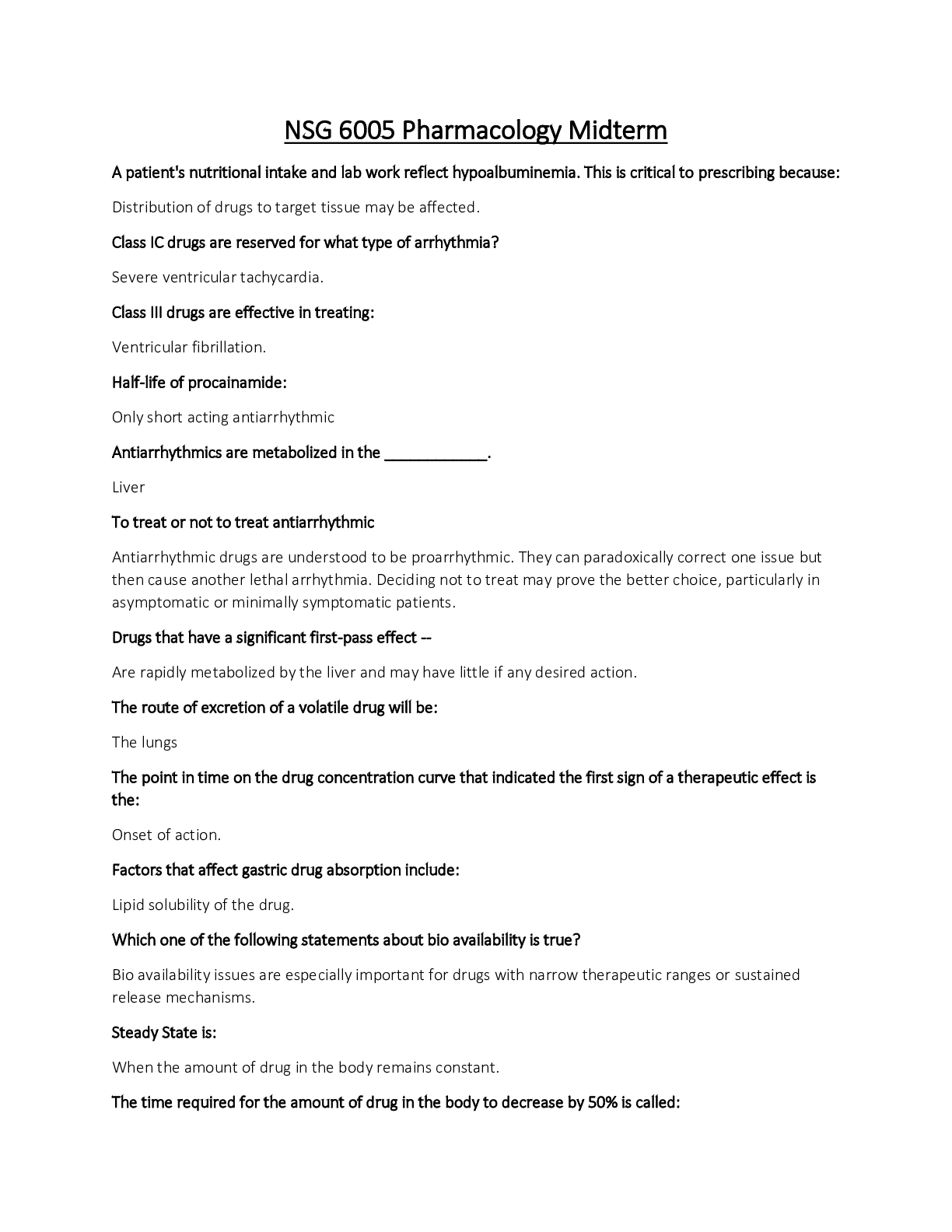
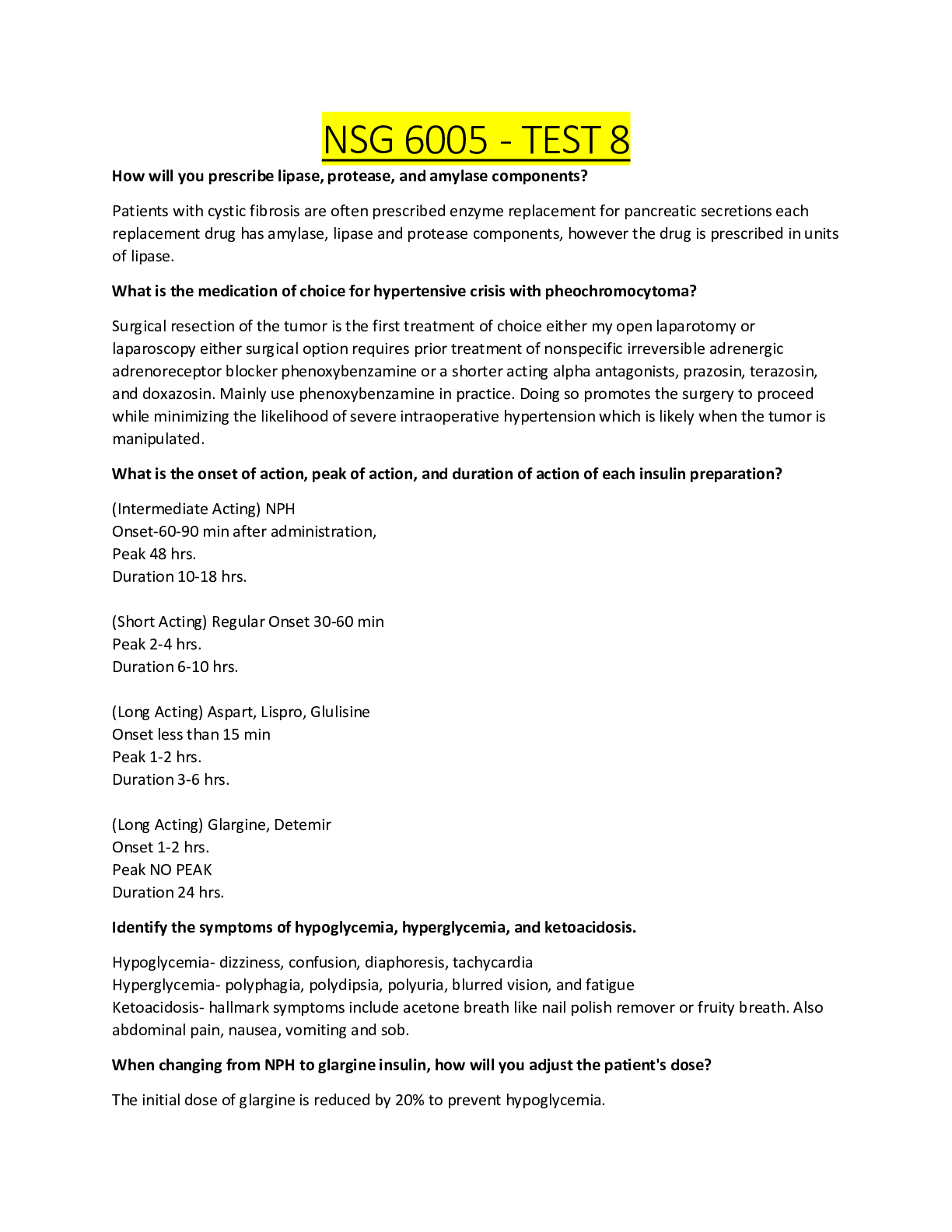
.png)
.png)
.png)
 (Q&A).png)
.png)
.png)
.png)

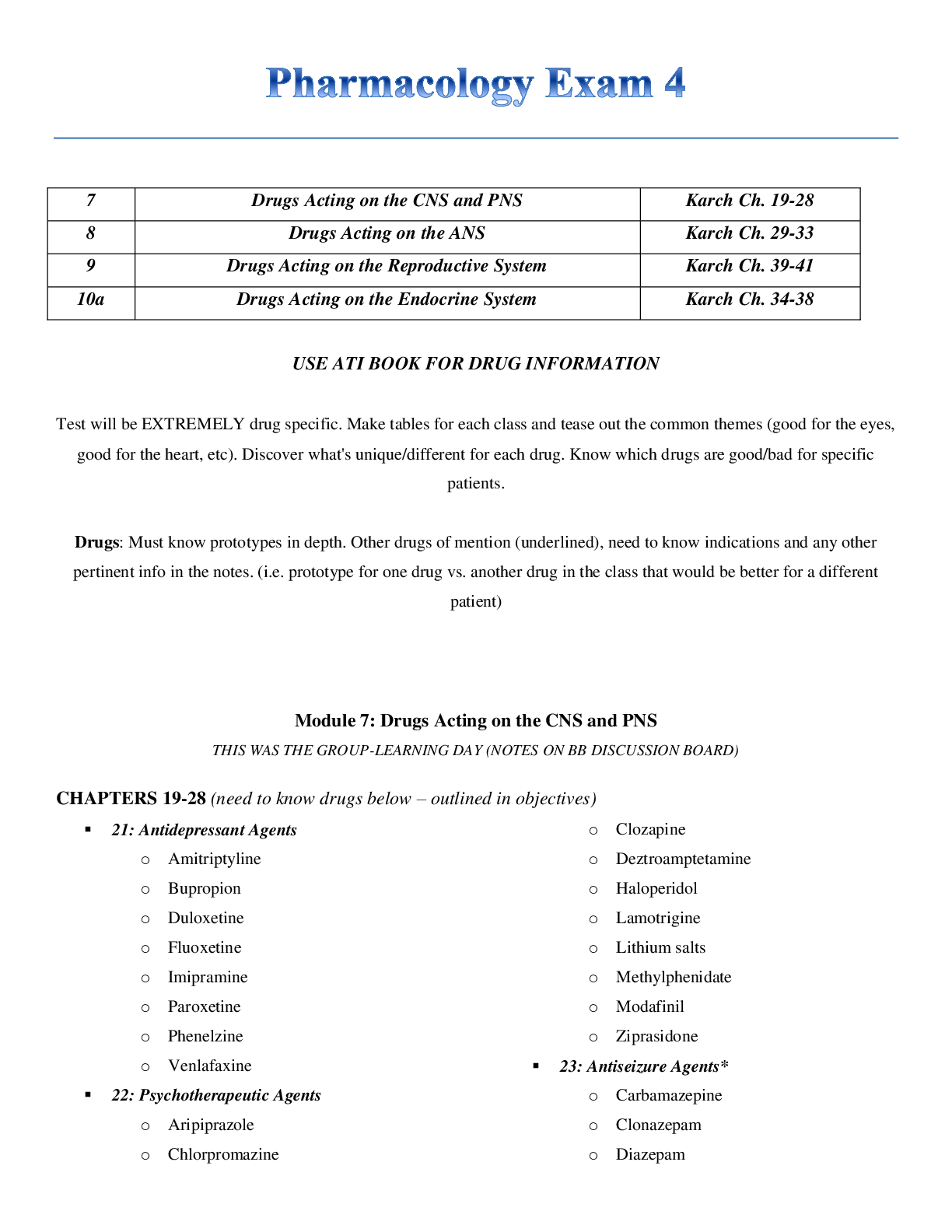
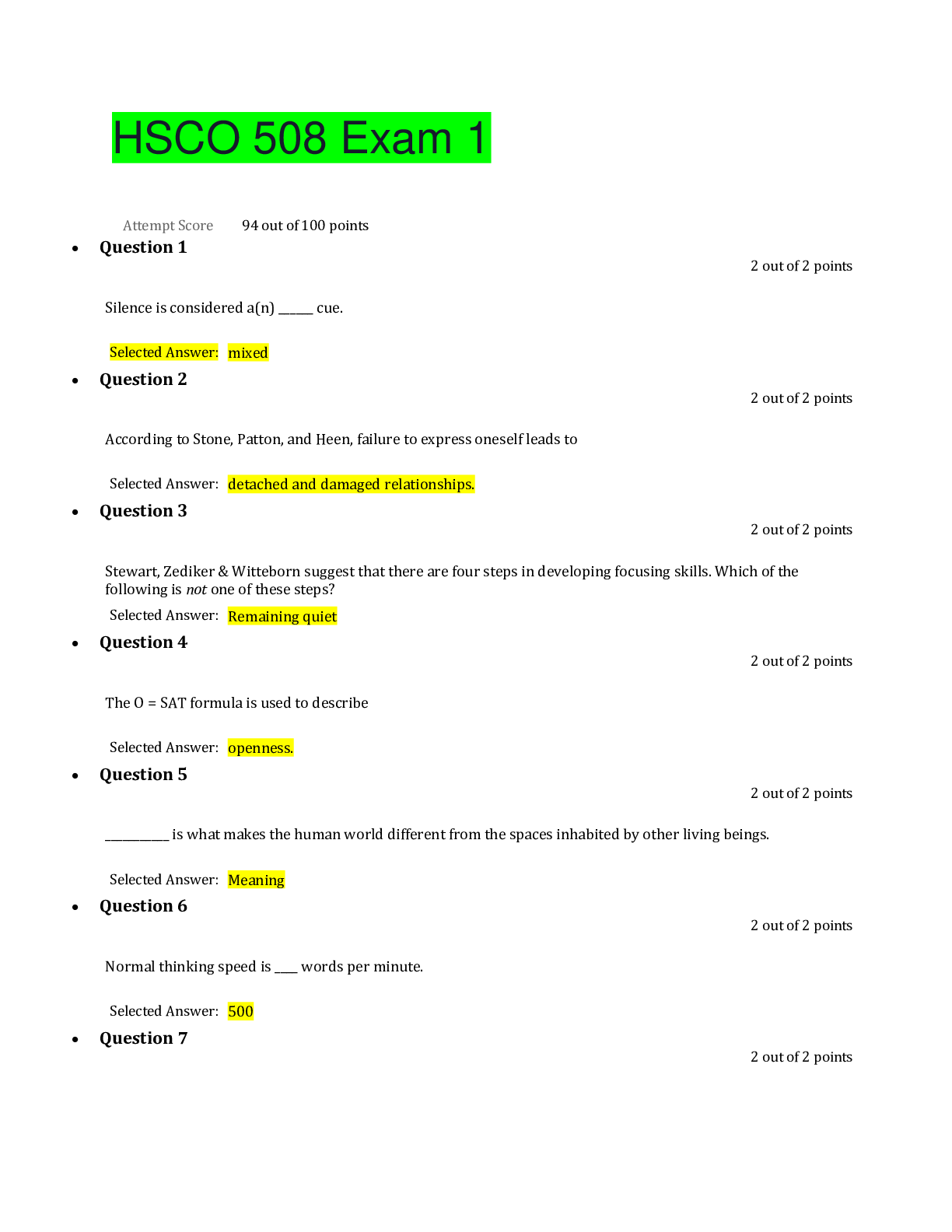

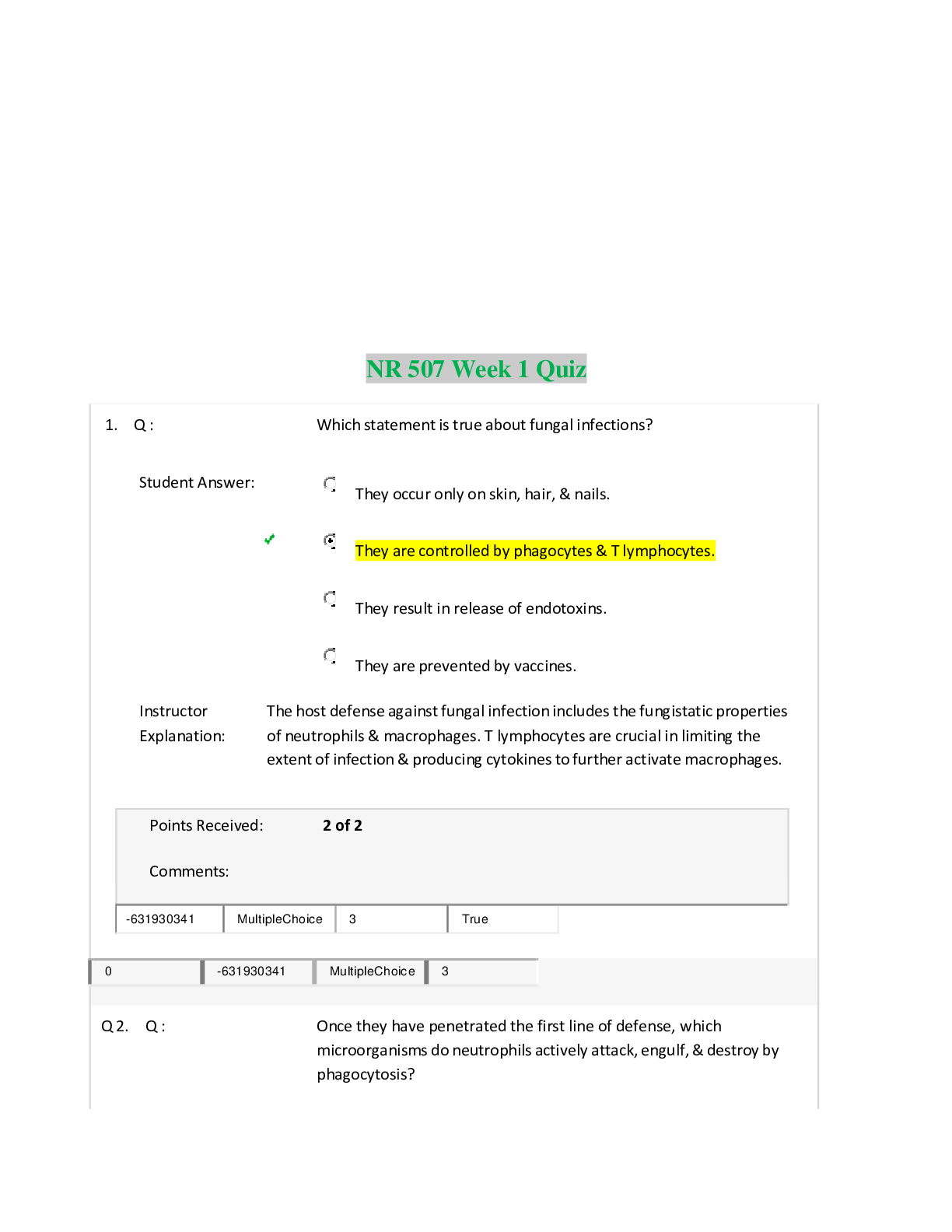


.png)

